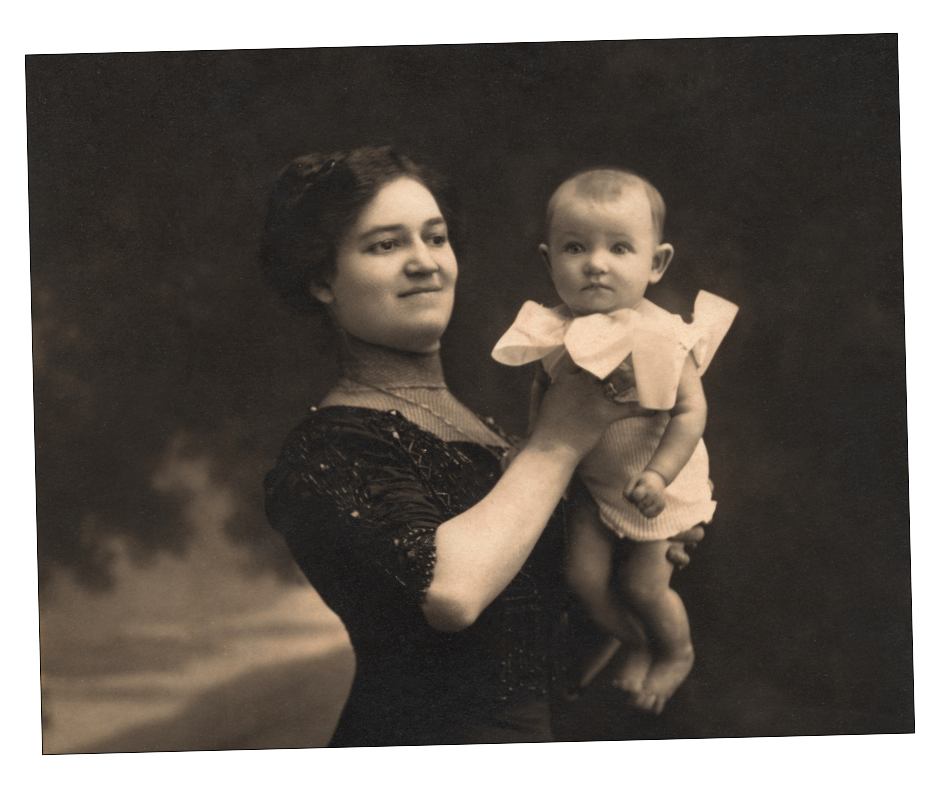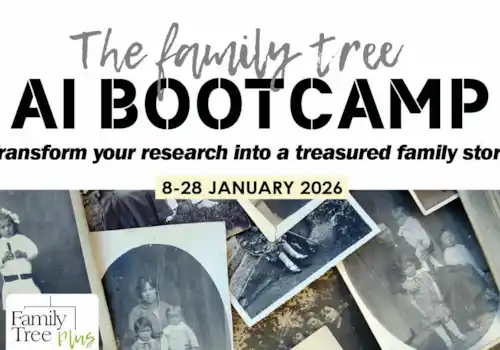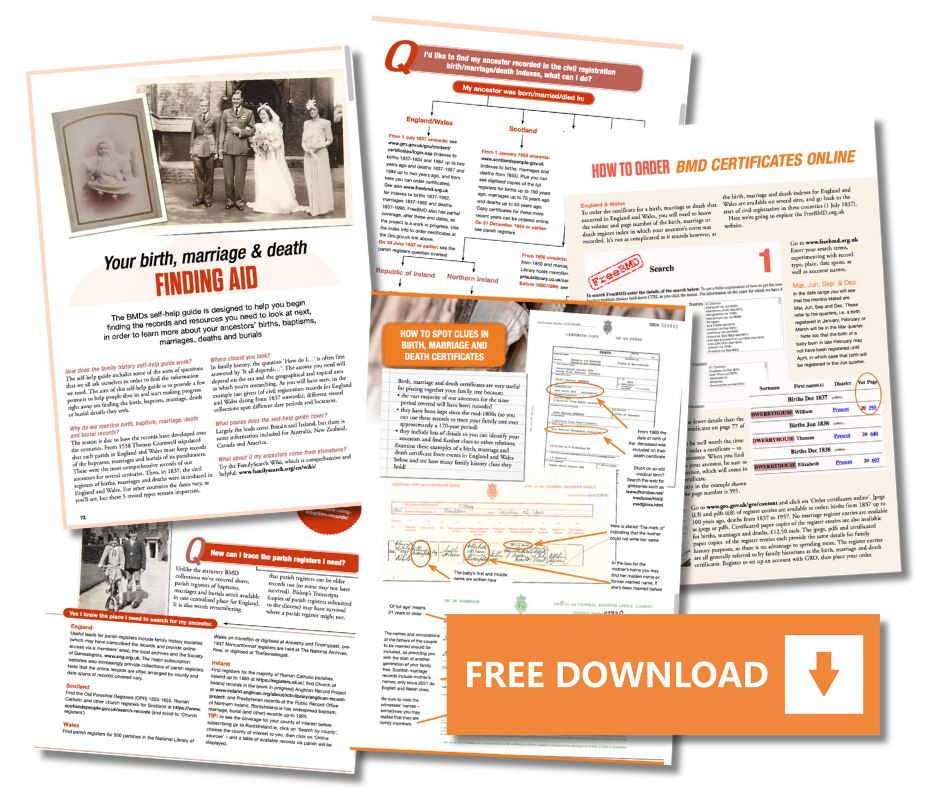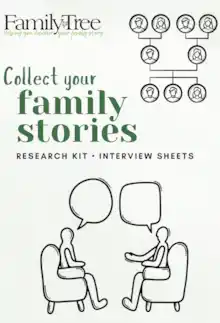The lives of our ancestors are punctuated by the dates of those vital life events: birth, marriage, and death. These records can provide much more information than just when these important events took place, shedding light on your ancestor's family, where they lived, and even their occupation. Find out more in our guide to using birth certificates.
Discover much more about using birth records for family tree research, and how these key resources can help you find your ancestors, with our in-depth guide.
Birth, marriage and death (BMD) records are one of the key building blocks of family history and will help you to identify major events in your ancestor’s life.
By obtaining birth records from the General Register Office (GRO), you’ll obtain important dates and facts about your ancestor and can take your family tree back another generation by discovering other family members.
Birth certificates - quick links
- Claim your free guide to finding, ordering, and using BMD records
- A quick introduction to birth records
- 60-second video guide to birth certificates
- How to get information from birth certificates
- Information held on birth certificates
- What if you can't find your ancestor's birth certificate?
- How to obtain a birth certificate online
The official civil registration of births, marriages and deaths in England and Wales began on 1 July 1837 (1 January 1855 for Scotland and 1 January 1864 for Ireland - and non-Roman Catholic marriages in Ireland had been recorded since 1845).
Before the introduction of the civil records, similar sorts of records had been kept by the church (these are known as parish registers, and largely cover baptisms, marriages and burials). However, there were increasingly concerns about the nature of this church record-keeping system. So it is in the Victorian era we see the state taking over the role of official registration of the births, marriages and deaths of the population.
The beginning of civil registration meant that the information collected about births, marriages and deaths was standardised and centralised, giving us, as family historians today, a much better chance of discovering information about our ancestors.
A quick introduction to birth records
A birth certificate gives the following information:
- date and place of birth
- name and occupation of the father
- name of the mother (with maiden name)
If the father isn’t named, this can indicate that the couple weren’t married or the father was unknown.
Having the name of the mother and father of an ancestor - as found on the ancestor's birth certificate - will help you to track down the marriage of your ancestor's parents. The place of birth can also be a help in finding the family in sources such as the census and street directories.
Watch this 60-second video guide to birth certificates
Family Tree's Helen Tovey gives us a whistle-stop one-minute guide to brith certificates and how useful they can be for family historians…
"Here we have a typical birth certificate. It has the baby’s first name — Thomas Dickin — and his date of birth. These are things you’d expect on a birth certificate. But from a family historian’s point of view, it gets so much more interesting.
"You have the parents’ names: Thomas Jones and Mary Ann Jones, née Pickering. From her maiden name, we can now look for a wedding certificate for the parents and start building our family history search backwards.
"You also have the father’s address and his occupation. These clues can help us really nail down the family in the census and make sure we’ve got the right people — especially with a common surname like Jones.
"Looking back at the baby’s date of birth (1868), we can search for him in the 1871 census. Suddenly, we can put that baby in context — and maybe discover he wasn’t the first child, or that there are older siblings. We’ll find a lot more about the family through census records."
How to get information from birth certificates
Before ordering a birth certificate, you should refer to the birth indexes online, to ensure you have found the correct ancestor.
The birth indexes can tell you the following about your ancestor:
- First name and surname
- Year the birth was registered
- Quarter the birth was registered
- January to March
- April to June
- July to September
- October to December
- These are often referred to as the March, June, September and December quarters
- Name of the registration district
- Volume and page number
- The mother's maiden name
(this is included for all births on the GRO index which you can find on the General Register Office website)
If this information helps to indicate that the ancestor in question is the one you are researching, you can purchase a copy of the birth certificate.
The information in the General Register Offices’ birth indexes is quite limited. Initially, just the name of child and the name of district in which the birth was registered are given; it wasn’t until the September quarter of 1911 that the mother’s maiden name was added.
While it’s usually possible to identify the correct entry in the indexes, it’s only after getting hold of a copy of the certificate itself that you will discover all the crucial genealogical information that it contains; the date and place of birth, the father’s name and the mother’s name and maiden surname.
The cheapest website on which to buy a copy of an English or Welsh birth certificate is the official government website.

Information held on an English or Welsh birth certificate
The information on an English or Welsh birth certificate includes:
- When and where born
- Name, if any
- Sex
- Name and surname of father
- Name, surname and maiden surname of mother
- Occupation of father (from 1984 the occupation of mother is recorded)
- Signature, description and residence of informant
- When registered
- Signature of registrar
- Name entered after registration
Birth certificates for Scotland
Civil registration wasn’t introduced north of the border until 1 January 1855 – but the system that was adopted was far more ambitious than that in place in England and Wales.
The range of questions asked in the first year of civil registration in Scotland was simply astonishing; in addition to the information recorded by the English GRO, the Scottish authorities required the following information: time of birth; the date and place of the parents’ marriage; the father’s age and birthplace; his previous issue, living and deceased (numbers and gender only), and the mother’s age and birthplace to be recorded.
This proved an impossible task to maintain and all but the first two were dropped in 1856.
The inclusion of the parents’ marriage details is enormously useful to us as family historians. See the ScotlandsPeople website. Bear in mind that the digital copies of the registers – giving all the details of a certificate – are available for many years.
Birth certificates for Ireland
In Ireland it was 1 January 1864 that the Irish GRO began the process of the civil registration of births. The system employed and the layout of the certificates were, with the addition of an explicit requirement to include the ‘dwelling place’ of the child’s father, identical to England and Wales.
For digitised collections of historic civil birth registers, see Irishgenealogy.ie This covers all of the island of Ireland until 1922. Just the Republic of Ireland is covered after that, and note that there a 100 year historic access restriction period - so that digitised copies of the birth registers for the Republic are not available within the past 100 years.
From 1922, births occurring in the six northern counties of Ireland were registered by the newly formed General Register Office (Northern Ireland). If seeking a birth certificate for someone born in the Republic of Ireland, see the General Register Office (GROI)
Birth certificates for the Channel Islands & the Isle of Man
Births have been registered by the civil authorities in Jersey since 1842, in Guernsey since 1840, in Alderney since 1850 (with some gaps) and in Sark since 1925. On the Isle of Man, the authorities began registration of non-Anglican births in 1849 but full civil registration wasn’t introduced until 1878 for births (and for marriages not until 1884).
What if you can't find your ancestor's birth certificate?
Dave Annal writes: Birth records are vital to our research: an essential component in our ongoing pursuit of our ancestors, providing the vital evidence that links us from one generation to an earlier one and it’s the failure to find the link that forms the essence of the classic family history brick wall. So, as all good researchers should, we continue to search.
But there’s a danger that in our desperate search for our ancestor’s origins we get too fixated on the idea of finding a record of their birth when what we’re actually looking for is evidence of their birth, or at least, evidence of their parentage.
There are any number of reasons why a record of someone’s birth may not be findable:
- The record may have been lost or so badly damaged as to be unreadable
- It may have been mistranscribed making it effectively untraceable
- It may simply not have been digitised and made available online: you might have to do some research to track down the physical location of a particular register, in a library or record office. Remember, however good the online coverage is nowadays, the material that we can access on the internet it is far from being a comprehensive record of what’s out there.
Of course the record may never have existed in the first place and we mustn’t ignore the very strong possibility that the person we’re looking for was born with a different name to the one that he or she routinely used in later life.
Finding evidence of parentage without a birth certificate
So, what does evidence of parentage look like and where might we find it?
We need to be a bit careful here as some of this evidence, for example evidence from a census record, isn’t necessarily reliable. Someone could easily be recorded as a son when they were actually a stepson, or a nephew, grandson or adopted son.
This could be due to a clerical error, ignorance or wilful deception (or a combination of the three) but either way, the discovery of someone listed in a census return as the son or daughter of the head of the household (remember this doesn’t necessarily mean that they were the son or daughter of the wife of the head of the household) will always represent an important clue in our quest.
One of the best places to find evidence of parentage is in our ancestors’ wills. Wills are packed full of relationships; understandably so, as it was important – in order to avoid possible disputes – that the identities of the beneficiaries were well-established.
Newspapers can also be a good source of this information, particularly for our poorer ancestors who might have had frequent brushes with the law. Similarly, records of the Poor Law authorities, both before and after the introduction of the New Poor Law in 1834.
How to obtain a birth certificate online
The quickest way to obtain a birth, marriage or death certificate is to find out the GRO reference before placing your order.
This shows the year the event was recorded (not necessarily the year it took place), the quarter of the year in which it was recorded, the district of registration, and the volume and page number.
You can search the GRO indexes for free online at Freebmd and on commercial websites including Ancestry and FindMyPast, which charge for the information.
Six large libraries (in Birmingham, Bridgend, Manchester, Newcastle, Plymouth and The British Library) plus the City of Westminster Archives Centre, offer free of charge access to the GRO indexes on microfiche, whilst a list of organisations which hold full or regional index microfiches can be found on the GRO website.
Once you’ve found the reference, visit the GRO website to order the certificate.
Scottish and Irish birth, marriage and death records
Civil registration of births, marriages and deaths in Scotland began from 1 January 1855 and you can obtain records from the ScotlandsPeople website.
BMD registration in Ireland dates to 1 January 1864, with certificates available from GRO Ireland and GRO Northern Ireland.
Claim your free BMD guide
Sign up to receive the Family Tree newsletter and we'll send you our free 'Birth Marriage and Death Guide' featuring:
- Your handy BMD finding aid (including finding records in the United Kingdom, Ireland, Australia, Canada, New Zealand, the USA)
- How to find clues on BMD records
- Your in-depth guide to ordering BMD records
You'll also receive our friendly, fun, and informative weekly email packed with expert tips, advice and special offers.
Sign up now








